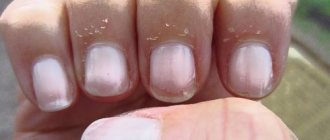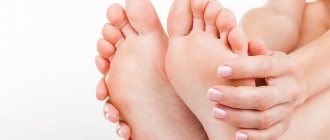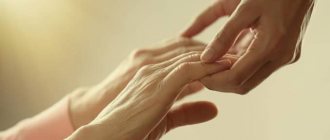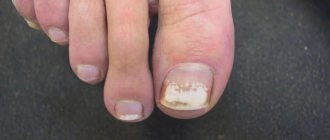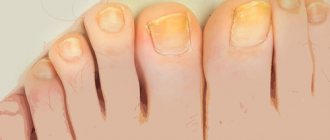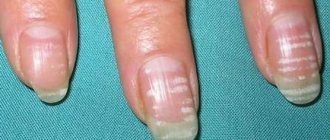Separation of the nail from the nail bed on the foot is a pathology that may indicate a bacterial, viral or fungal infection. Most often this happens when hygiene rules are not followed after visiting public places with high humidity. In addition, detachment can begin due to severe vitamin deficiency, chronic diseases of internal organs and after nail injuries. You can get rid of this problem with the help of medications and folk remedies.
Why does the nail peel off?
There are many factors that provoke the development of onycholysis. The separation of the nail plate could be caused by:
- The nail on the thumb is moving away from the skin.
Injury to the phalanx of the finger or the stratum corneum. Damage could occur due to mechanical or chemical influence. As a result of an impact, strong pressure or burn, the vital activity of cells is disrupted, tissue necrosis occurs and the nail peels off. - Walking in tight shoes. If the thumbs are constantly in a compressed state, blood circulation is disrupted, nutrition of the horny plate deteriorates, and tissue rejection occurs.
- Poor quality pedicure. Injury can result from careless sharpening or careless cutting of the nail.
It's possible that it's not just your big toenails that are peeling, but several of your toenails at once. The cause of this pathology may be:
Psoriasis of toenails
- Dermatological diseases - eczema or psoriasis of the stratum corneum.
- Long-term use of tetracycline and fluoroquinolone antibiotics.
- Chronic diseases of the cardiovascular, endocrine, nervous or digestive systems that affect the condition of the nails.
- Fungal infection of the feet, localized on the horny plate.
Most often, toenails detach from the skin due to a parasitic fungus. Before treating an infection, you need to find out what pathogen is causing it.
Leukonychia - why the nail hurts: causes of toenail pathology
Leukonychia - painful nail
Leukonychia disease is accompanied by the appearance of small white spots on the nail bed. The degree of damage is individual - from isolated cases to multiple manifestations. Why does my nail hurt? The causes of this toenail pathology are varied. These include:
- Impact of external factors
- Traumatic situations
- Chemical lesions
In addition, internal pathologies lead to the development of the disease - metabolic disorders, infectious diseases, lesions in the central nervous system.
Symptoms of onycholysis
As a rule, detachment is painless. This often makes it difficult to notice the initial signs of the disease. Be attentive to yourself, then you will not miss the first call. Incipient onycholysis makes itself felt with the following symptoms:
- Change in color of the nail on the big toe after an injury,
the border line between the white and pink parts of the nail plate begins to bulge and becomes uneven; - the nail completely or partially changes its usual color to blue, yellow or white. With an impact and a hematoma, the horny covering may turn black (see photo of a hematoma on the big toe);
- the nail plate thickens;
- nail growth stops.
When the connection between the stratum corneum and the soft tissues is disrupted, voids form under the nail. The pathological process can cover the entire area of the nail plate and end in complete rejection. Outwardly it looks untidy; Therefore, it is important to diagnose the development of onycholysis in time.
Signs of onycholysis
What to do at the first signs of the disease? The right decision would be to visit a doctor. Fungus, psoriasis, and eczema are treated by a dermatologist; examination by a more specialized specialist, a mycologist, is possible.
Important! If the doctor confidently diagnoses a fungal disease during a visual examination, look for another specialist. It can only be stated that the cause of damage to the stratum corneum is a fungus after appropriate tests have been carried out.
If the nail detachment began after an injury, you will need to consult a surgeon.
Treatment of onychodystrophy at the Podology Clinic
The Podology Clinic, which is one of the largest technically equipped specialized complexes in Russia, offers to take advantage of the priorities of innovative medical technologies aimed at solving a wide range of problems of the feet and nails. Experienced podologists who master all known techniques have at their disposal the most advanced expert-class diagnostic and treatment equipment, ensuring the most accurate and painless correction.
If you have problems with your fingernails and toenails, you shouldn’t leave them to chance. Only a timely visit to a professional involved in the treatment of various onychopathies will help to identify and carry out full correction at the earliest stages, without aggravating the development of dystrophic changes. And don’t forget that nails play not only an aesthetic role, but are also an indicator of your health.
Video review of the PinPointe FootLaser laser and interview with Dmitry Zakharchenko (CEO) on the latest device for the treatment of onychodystrophy and onychomycosis:
Drug treatment
The choice of therapy will depend on the primary causes of the problem. In case of traumatic damage, it is enough to keep the nail clean, treat it with antiseptic agents, carefully trim it and wait for a new plate to grow.
For systemic diseases, local treatment is ineffective: an integrated approach is required to eliminate or reduce relapses of the underlying disease. If the nail moves away from the nail bed after taking antibiotics, the condition will return to normal after stopping the drugs. As the healthy nail grows, the damaged part will be pushed out.
The most difficult thing to achieve is the treatment of fungal infections. It takes a lot of time - from several months to several years. The doctor will prescribe you antifungal chemotherapy drugs. Complex treatment includes oral antimycotics:
Toenail fungus
- Fluconazole;
- Intracanazole;
- Ketoconazole;
- Griseofulfin.
Also used for external use:
- Clotrimazole;
- Bifonazole;
- Ciclopirox in the form of varnish, cream or solution;
- Oxytetracycline ointment;
- Terbinafine and other medications at the discretion of the treating healthcare professional.
To improve microcirculation and ensure the supply of nutrients to the nail bed, the doctor will prescribe massage or physiotherapeutic procedures. He will also prescribe strengthening vitamin complexes and preparations containing active calcium ions. This element is necessary to strengthen the nail plate.
Ringworm: Toenail Fungus
Ringworm: Toenail Fungus
It is a popular misconception that ringworm only affects the skin and hair. Unfortunately, doctors talk about an existing form of pathology that affects the toenails.
- Infection with this fungus is transmitted from contact with a patient or through his hygiene items.
- Presuming factors are decreased immunity, vitamin deficiency, and the presence of chronic forms of diseases.
External signs of the disease are similar to other fungal pathologies:
- Changing the appearance of nail plates
- Thickening, separation and crumbling of the nail bed
- The appearance of longitudinal grooves on the plate
When the form is advanced, the nail begins to separate from the bed. In most cases, the disease occurs in isolation, but sometimes doctors note simultaneous damage to the skin and hair.
Treatment with folk remedies
There are various solutions to improve the health of the stratum corneum at home. It is unlikely that it will be possible to cure a diseased nail using folk recipes; these procedures can be considered as an adjuvant to drug therapy. Comprehensive measures will help stop the process of onycholysis. You can prepare medicinal baths, lotions, mixtures for rubbing into the affected area:
- Mix freshly squeezed juice of one orange with 1 tbsp. l. salt, 4-5 drops of iodine and 50 ml of mineral water at room temperature. Keep your fingers in this solution for 10-15 minutes. This recipe is suitable when nail detachment and void formation are in the initial stages.
- Add apple cider vinegar or hydrogen peroxide to warm water in a 2:1 ratio. This bath is effective when the toenail is completely separated from the toe. Do it 2 times a day for 20 minutes.
- Add 0.5 tsp. gelatin in 200 g of water and let it brew for 30 minutes. Then heat the solution and immerse the damaged nail in it for 15 minutes. Repeat the procedure every other day until the condition of the plate improves.
- Steam 1 tbsp with a glass of boiling water. l. dry pharmaceutical chamomile and pine needles. Let it brew for 30 minutes, then strain and combine with green tea (1:1). Take the bath for half an hour, repeat the procedure every day.
- Use iodine. Apply a thin layer of it to the affected part before going to bed. Do this for several days in a row - 1-2 weeks.
- Prepare a mixture of crushed garlic and butter. Take the ingredients in equal proportions. Rub the product into the sore nail. Repeat the procedure every day or every other day until positive results are achieved.
- It is very useful to rub sea buckthorn or olive oil into the damaged nail before going to bed.
Before applying various compounds to the stratum corneum, the surface to be treated should be steamed and cleaned of contaminants.
How is the diagnosis done?
The lesion may affect just one finger, several fingers, or all of them at once. This symptom is important for diagnosis, as it suggests the cause of dystrophy. If only one finger is injured, then most likely it is due to injury. If there are several, there are systemic violations.
The diagnosis is made by a dermatologist or podologist. First, inspects the problem area. Then, to find out the cause, he clarifies: whether the person has suffered viral infections over the past two months, what medications he took, whether there were any injuries, whether there are skin diseases. If necessary, prescribe a study of scraping the plate for fungus, a blood test for viral infections, autoimmune, systemic, and inflammatory diseases.
Nail removal
In particularly advanced cases, when the infection is severe or the nail has almost completely come away from the skin, the doctor may recommend surgery to amputate the horny plate. The procedure is painful and is performed under local anesthesia. During the recovery period, therapeutic bandages are applied to the finger using antibacterial agents.
There is a chemical way to remove damaged nails. It is based on the use of keratolytic components that dissolve the horny part. You can purchase drugs such as Nogtimycin, Nogtevit at the pharmacy and, following the instructions, remove the nail yourself.
Removing a nail with a pedicure machine
You can also get rid of the nail plate when it peels off using a hardware pedicure or laser (see photo of big toe nail removal). Find out if this procedure is performed at your nearest cosmetology clinic. Within 2-3 months, a new nail will begin to grow, and if you have eliminated the root cause of the disease, you can guarantee that it will be healthy.
To quickly restore the stratum corneum, it is recommended to take a gelatin solution. Pour in 2 tsp. edible gelatin 100 g of warm water and leave to swell. Then heat the solution in a water bath, add another 100 g of water. When the crystals are completely dissolved, add 1 tsp. lemon juice and drink. Drink gelatin an hour before meals in the morning for 2 weeks. Then they take a break for a week and repeat the course again.
Tactics for onycholysis. Which doctor treats onycholysis?
In order for the treatment of onycholysis to be successful, problems with the stomach, heart, thyroid gland, etc., which could provoke detachment of the nail plate, should be identified and eliminated.
Knowing about this relationship, a competent dermatologist does not ask the question of how to cure exfoliation on the arms or legs - he will definitely send the patient to specialized specialists who will examine him and prescribe treatment.
Whatever the reason for the detachment of the nail plate, in any of the cases a course of general restoratives is prescribed:
- vitamins (primarily A and group B);
- iron supplements;
- calcium both in the form of pharmaceuticals and in food (cottage cheese, milk).
Preventive measures
The following preventive measures will help prevent the development of onycholysis:
- regularly monitor foot hygiene;
- try not to injure your nails (for example, when performing repair and construction work, wear closed shoes or sneakers);
- to avoid fungal infection, do not wear someone else’s shoes;
- avoid direct contact with chemicals;
- trim the overgrown part of the nail plate in a timely manner;
- don’t get carried away with nail extensions;
- do not buy tight shoes;
- keep your feet dry, avoiding high humidity;
- Treat chronic diseases in a timely manner.
By following these recommendations, you will maintain healthy nails.
What to do to speed up the healing process?
In case of a nail injury, doctors recommend:
- Cold compresses. Cooling will help relieve pain, reduce swelling and stop bleeding. On the day you are injured, apply ice to the wound every two hours. For convenience, place ice cubes in a bag and wrap them in a towel. Apply cold compresses 3-4 times a day throughout the following days.
- Keep the injured limb elevated. Especially if the finger is swollen. Try to keep your hand above the level of your heart, placing it on a table or pillow. If your toe is injured, take a horizontal position more often and stretch your leg onto a pillow or armrest.
- Refrain from wearing tight shoes. If possible, wear only soft, loose shoes that will not put pressure on the injured toe. Walk around the house barefoot or in slippers until the toe is completely healed.
- Take over-the-counter pain relievers. Ibuprofen, Nurofen or Naproxen are perfect for this purpose: they reduce swelling and relieve pain. If the injured finger does not swell, you can take Acetaminophen.
Note! The fact that drugs are dispensed without a prescription does not mean that they can be taken uncontrolled. Make sure in advance that you have no contraindications for use and consult your doctor.
On average, a nail grows completely in six months to a year. You will have to be patient and make every effort to ensure that the new nail plate takes its “rightful” place.
A torn nail on the little finger or other finger is a fairly common situation, and there is no need to be alarmed. Timely treatment and consultation with a doctor will help you quickly solve the problem and return to your normal lifestyle without pain and discomfort.


